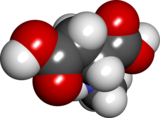NMDA
 |
|
 |
|
 |
|
| Names | |
|---|---|
|
IUPAC name
(2R)-2-(Methylamino)butanedioic acid
|
|
| Other names
N-Methylaspartate; N-Methyl-D-aspartate; NMDA
|
|
| Identifiers | |
|
6384-92-5 |
|
| 3D model (Jmol) |
Interactive image Interactive image |
| 1724431 | |
| ChEBI |
CHEBI:31882 |
| ChEMBL |
ChEMBL291278 |
| ChemSpider |
21436 |
| 4268 | |
| KEGG |
C12269 |
| MeSH | N-Methylaspartate |
| PubChem | 22880 |
| RTECS number | CI9457000 |
|
|
|
|
| Properties | |
| C5H9NO4 | |
| Molar mass | 147.13 g·mol−1 |
| Appearance | White, opaque crystals |
| Odor | Odorless |
| Melting point | 189 to 190 °C (372 to 374 °F; 462 to 463 K) |
| log P | 1.39 |
| Acidity (pKa) | 2.206 |
| Basicity (pKb) | 11.791 |
| Hazards | |
| S-phrases | S22, S24/25 |
| Lethal dose or concentration (LD, LC): | |
|
LD50 (median dose)
|
137 mg kg−1 (intraperitoneal, mouse) |
| Related compounds | |
|
Related amino acid derivatives
|
|
|
Related compounds
|
Dimethylacetamide |
|
Except where otherwise noted, data are given for materials in their standard state (at 25 °C [77 °F], 100 kPa).
|
|
|
|
|
| Infobox references | |
N-Methyl-D-aspartic acid or N-Methyl-D-aspartate (NMDA) is an amino acid derivative that acts as a specific agonist at the NMDA receptor mimicking the action of glutamate, the neurotransmitter which normally acts at that receptor. Unlike glutamate, NMDA only binds to and regulates the NMDA receptor and has no effect on other glutamate receptors (such as those for AMPA and kainate). NMDA receptors are particularly important when they become overactive during withdrawal from alcohol as this causes symptoms such as agitation and, sometimes, epileptiform seizures.
NMDA is a water-soluble synthetic substance that is not normally found in biological tissue. It was first synthesized in the 1960s. NMDA is an excitotoxin (it kills nerve cells by over-exciting them); this trait has applications in behavioral neuroscience research. The body of work utilizing this technique falls under the term "lesion studies". Researchers apply NMDA to specific regions of an (animal) subject's brain or spinal cord and subsequently test for the behavior of interest, such as operant behavior. If the behavior is compromised, it suggests the destroyed tissue was part of a brain region that made an important contribution to the normal expression of that behavior.
However, in lower quantities NMDA is not neurotoxic. In fact, normal operation of the NMDA receptor allows individuals to respond to excitatory stimuli through the interrelated functioning of NMDA receptors, glutamate, and dopamine.
Therefore the action of glutamate specifically through NMDA receptors can be investigated by injecting small quantities of NMDA into a certain region in the brain: for example, injection of NMDA in a brainstem region induces involuntary locomotion in cats and rats.
...
Wikipedia
